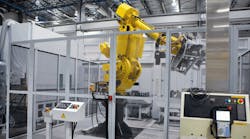Things aren't as dire as they appear. Human beings will still find employment even as automation-enabling technologies – e.g., robotics, machine learning, and artificial Intelligence (AI) make inroads in the manufacturing sector.
“Most products are still assembled by human hands, monitored by localized systems, and inspected manually,” said Ryan Martin, principal analyst at ABI Research, discussing his company’s study, "Smart Workforces: Transformative Technologies for New Employment Paradigms."
“Digitizing these processes amplifies the value—and payback profile—of balancing IT and OT asset availability with existing operational improvement projects,” Martin added.
What will change is the nature and scope of the jobs. “Transformative technologies like robotics, ML, and AI may substitute specific tasks previously carried out by humans, but they will also allow those professionals to focus on new tasks – and these new tasks will, by nature, redefine the core skills associated with the occupation at hand.”
One example is Amazon’s use of Robotic Process Automation (RPA) in Prime fulfillment centers. Contrary to the popular belief that the use of robotics would eat jobs, there are instances where net-new hires increased as result of overall efficiency improvements in e-commerce throughput.
Another example is Walmart’s use of robots from Bossa Nova Robotics to scan shelves for out-of-stock items, check prices, and identify missing labels for a near-real-time view of which areas of the store need the most attention. Here, shelf-scanning technology is used in combination with robots to help associates with repeatable, predictable, and manual tasks so they can focus on better serving the customer.
Lowe’s has a similar implementation with Fellow Robots, but for greeting and leading customers to the desired product; and Volvo Trucks is working with Uber Freight to eliminate inefficiencies in downstream logistics (due to wait time and/or the mix of short-haul versus long-haul trips) by coordinating load pickups and drop-offs with local truckers, changing the nature of not only trucking but also intermodal logistics.
“The introduction and wider availability of self-service analytics, machine learning, and AI simply helps level the playing field by focusing the conversation on how to supplement—rather than supplant—today’s employees, putting the lens on the job itself rather than the organization or environment in which it resides,” concluded Martin.
But this adoption of technology is slow. The report found that 67% of manufacturing respondents did not have IoT solutions in operation. Of those, 74% were either investigating, assessing, or planning to deploy such solutions in the next 12 months. Survey results show that while a lot of the activity in non-connectivity categories are relatively simplistic deployments, industrial IoT (IIoT) applications share a common propensity for automation enablement: 35% of respondents in manufacturing are assessing AI, and 47% have either deployed or plan to deploy robotics solutions in the next 12 months.



